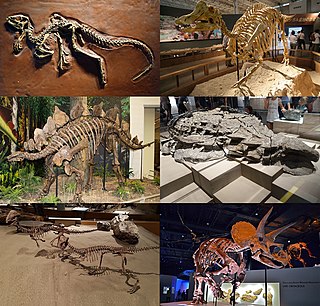
Ornithischia is an extinct clade of mainly herbivorous dinosaurs characterized by a pelvic structure superficially similar to that of birds. The name Ornithischia, or "bird-hipped", reflects this similarity and is derived from the Greek stem ornith- (ὀρνιθ-), meaning "bird", and ischion (ἴσχιον), meaning "hip". However, birds are only distantly related to this group as birds are theropod dinosaurs. Ornithischians with well known anatomical adaptations include the ceratopsians or "horn-faced" dinosaurs, the pachycephalosaurs or "thick-headed" dinosaurs, the armored dinosaurs (Thyreophora) such as stegosaurs and ankylosaurs, and the ornithopods. There is strong evidence that certain groups of ornithischians lived in herds, often segregated by age group, with juveniles forming their own flocks separate from adults. Some were at least partially covered in filamentous pelts, and there is much debate over whether these filaments found in specimens of Tianyulong, Psittacosaurus, and Kulindadromeus may have been primitive feathers.

Thyreophora is a group of armored ornithischian dinosaurs that lived from the Early Jurassic until the end of the Cretaceous.

Ankylosauria is a group of herbivorous dinosaurs of the clade Ornithischia. It includes the great majority of dinosaurs with armor in the form of bony osteoderms, similar to turtles. Ankylosaurs were bulky quadrupeds, with short, powerful limbs. They are known to have first appeared in the Middle Jurassic, and persisted until the end of the Cretaceous Period. The two main families of Ankylosaurs, Nodosauridae and Ankylosauridae are primarily known from the Northern Hemisphere, but the more basal Parankylosauria are known from southern Gondwana during the Cretaceous.

Kentrosaurus is a genus of stegosaurid dinosaur from the Late Jurassic in Lindi Region of Tanzania. The type species is K. aethiopicus, named and described by German palaeontologist Edwin Hennig in 1915. Often thought to be a "primitive" member of the Stegosauria, several recent cladistic analyses find it as more derived than many other stegosaurs, and a close relative of Stegosaurus from the North American Morrison Formation within the Stegosauridae.
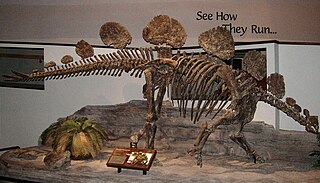
Hesperosaurus is a herbivorous stegosaurian dinosaur from the Kimmeridgian age of the Jurassic period, approximately 156 million years ago.
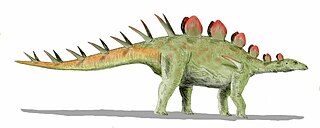
Chialingosaurus is a genus of herbivorous stegosaurian dinosaur similar to Kentrosaurus from the Upper Shaximiao Formation, Late Jurassic beds in Sichuan Province in China. Its age makes it one of the oldest species of stegosaurs, living about 160 million years ago. Since it was an herbivore, scientists think that Chialingosaurus probably ate ferns and cycads, which were plentiful during the period when Chialingosaurus was alive.

Wuerhosaurus is a genus of stegosaurid dinosaur from the Early Cretaceous Period of China and Mongolia. As such, it was one of the last genera of stegosaurians known to have existed.
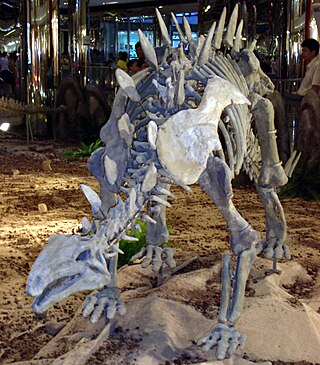
Huayangosaurus is a genus of stegosaurian dinosaur from the Middle Jurassic of China. The name derives from "Huayang" (華陽), an alternate name for Sichuan, and "saurus", meaning "lizard". It lived during the Bathonian to Callovian stages, around 165 million years ago, some 20 million years before its famous relative, Stegosaurus appeared in North America. At only approximately 4 metres (13 ft) long, it was also much smaller than its famous cousin. Found in the Lower Shaximiao Formation, Huayangosaurus shared the local Middle Jurassic landscape with the sauropods Shunosaurus, Datousaurus, Omeisaurus and Protognathosaurus, the ornithopod Xiaosaurus and the carnivorous Gasosaurus.

Tuojiangosaurus is a genus of herbivorous stegosaurian dinosaur from the Late Jurassic Period, recovered from the Upper Shaximiao Formation of what is now Sichuan Province in China.
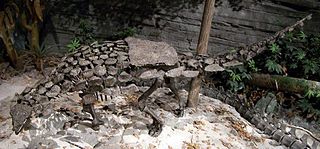
Nodosauridae is a family of ankylosaurian dinosaurs known from the Late Jurassic to the Late Cretaceous periods in what is now Asia, Europe, North America, and possibly South America. While traditionally regarded as a monophyletic clade as the sister taxon to the Ankylosauridae, some analyses recover it as a paraphyletic grade leading to the ankylosaurids.

Paranthodon is a genus of stegosaurian dinosaur that lived in what is now South Africa during the Early Cretaceous, between 139 and 131 million years ago. Discovered in 1845, it was one of the first stegosaurians found. Its only remains, a partial skull, isolated teeth, and fragments of vertebrae, were found in the Kirkwood Formation. British paleontologist Richard Owen initially identified the fragments as those of the pareiasaur Anthodon. After remaining untouched for years in the British Museum of Natural History, the partial skull was identified by South African paleontologist Robert Broom as belonging to a different genus; he named the specimen Palaeoscincus africanus. Several years later, Hungarian paleontologist Franz Nopcsa, unaware of Broom's new name, similarly concluded that it represented a new taxon, and named it Paranthodon owenii. Since Nopcsa's species name was assigned after Broom's, and Broom did not assign a new genus, both names are now synonyms of the current binomial, Paranthodon africanus. The genus name combines the Ancient Greek para (near) with the genus name Anthodon, to represent the initial referral of the remains.

Stegosauria is a group of herbivorous ornithischian dinosaurs that lived during the Jurassic and early Cretaceous periods. Stegosaurian fossils have been found mostly in the Northern Hemisphere, predominantly in what is now North America, Europe, Africa, South America and Asia. Their geographical origins are unclear; the earliest unequivocal stegosaurian, Bashanosaurus primitivus, was found in the Bathonian Shaximiao Formation of China.

Stegosauridae is a family of thyreophoran dinosaurs within the suborder Stegosauria. The clade is defined as all species of dinosaurs more closely related to Stegosaurus than Huayangosaurus. The name ‘Stegosauridae’ is thus a stem-based name taken from the well-represented genus – Stegosaurus. Fossil evidence of stegosaurids, dating from the Middle Jurassic through the Early Cretaceous, have been recovered from North America, Eurasia and Africa.
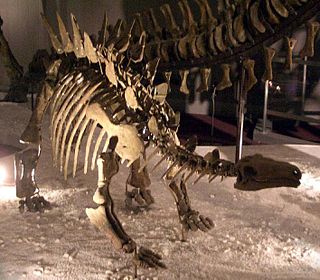
Chungkingosaurus, meaning "Chongqing Lizard", is a genus of herbivorous dinosaur from the Late Jurassic Upper Shaximiao Formation in what is now China. It is a member of the Stegosauria.

Gigantspinosaurus is a genus of herbivorous ornithischian dinosaur from the Late Jurassic. It was a stegosaur found in China.

This timeline of stegosaur research is a chronological listing of events in the history of paleontology focused on the stegosaurs, the iconic plate-backed, spike-tailed herbivorous eurypod dinosaurs that predominated during the Jurassic period. The first scientifically documented stegosaur remains were recovered from Early Cretaceous strata in England during the mid-19th century. However, they would not be recognized as a distinct group of dinosaurs until Othniel Charles Marsh described the new genus and species Stegosaurus armatus in 1877, which he regarded as the founding member of the Stegosauria. This new taxon originally included all armored dinosaurs. It was not until 1927 that Alfred Sherwood Romer implemented the modern use of the name Stegosauria as specifically pertaining to the plate-backed and spike-tailed dinosaurs.
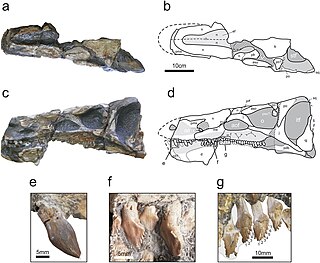
Isaberrysaura is a genus of stegosaurian ornithischian dinosaur from the Middle Jurassic Los Molles Formation of Patagonia, Argentina. The genus contains a single species, I. mollensis, described by Salgado et al. in 2017 from a single specimen. Although initially classified as a basal neornithischian, subsequent analysis has allied it with the Stegosauria; the morphology of its skull resembles those of other members of the group.

Susannah "Susie" Catherine Rose Maidment is a British palaeontologist at the Natural History Museum, London. She is internationally recognised for her research on ornithischian dinosaur evolution, and was awarded the 2016 Hodson Award of the Palaeontological Association and the 2017 Lyell Fund of the Geological Society of London. She was featured as a 2019 National Geographic Women of Impact.

Bashanosaurus is an extinct genus of stegosaurian dinosaur from the Middle Jurassic Shaximiao Formation of Yunyang County, China. The genus contains a single species, Bashanosaurus primitivus, known from incomplete skeletons belonging to three individuals. It is one of the basalmost stegosaurs, as well as one of the oldest known stegosaurs, along with Adratiklit, Isaberrysaura, and Thyreosaurus.



















